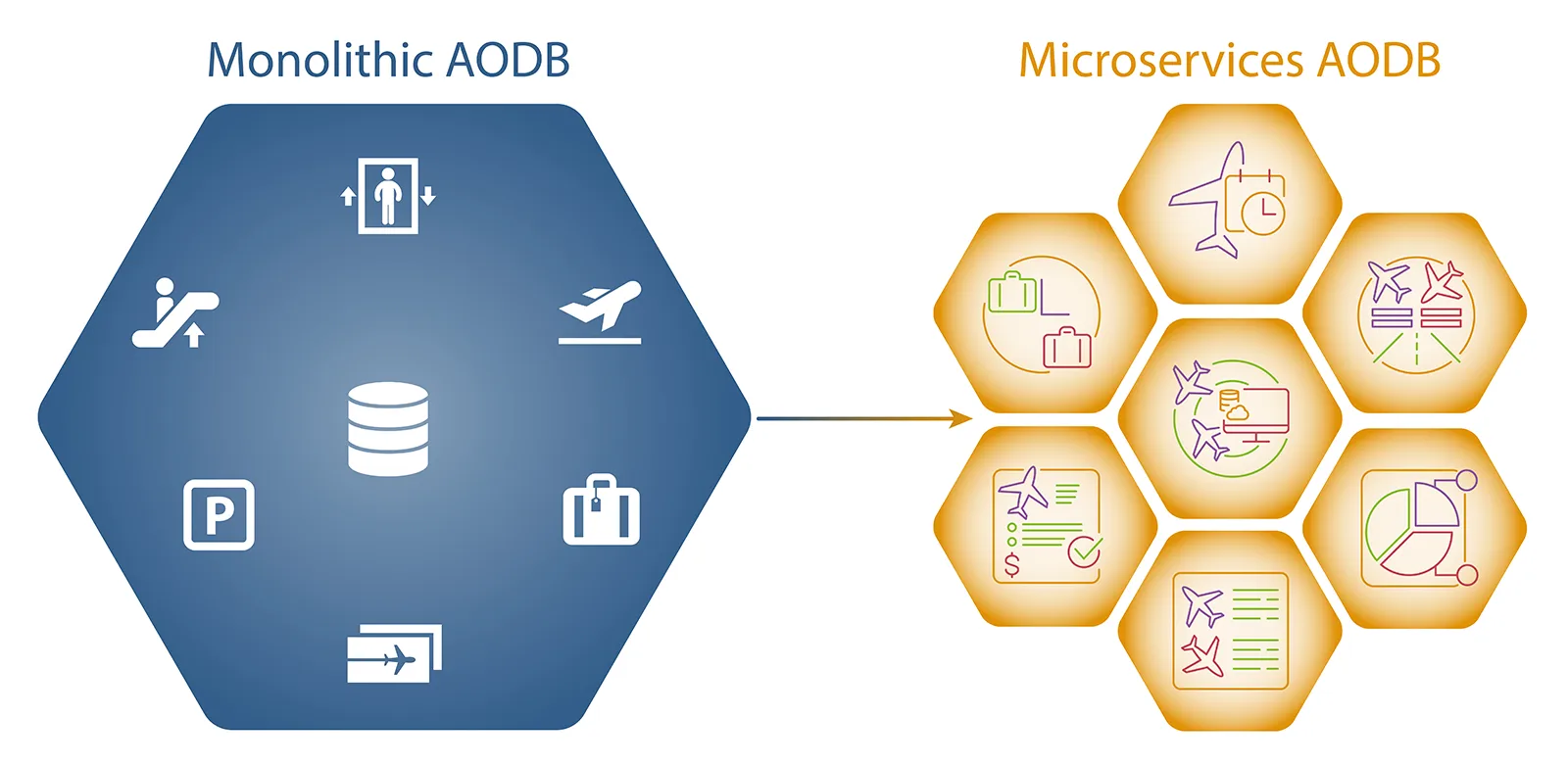Why is Digital Transformation so Important?
Digital transformation is the process of integrating digital technologies into various aspects of a business to fundamentally change how it operates and delivers value to its customers. It involves leveraging digital tools, technologies, and data to enhance efficiency, improve customer experiences, and stay competitive in today’s rapidly evolving digital landscape.
A significant roadblock for digital transformation within airports is the reliance on monolithic Airport Operational Databases (AODB). They are essential in terms of functionality, but their fundamental architecture now hinders digital transformation initiatives.
Digital transformation is not just about technology adoption; it should also enable agility and innovation across the airport to change operations and deliver value. This is essential for airport evolution, market adaptability, and delivering value to the airport business stakeholders, passengers, and guests.
Understanding a Monolithic AODB
A monolithic AODB integrates various airport operational functions into a single, inseparable unit such as a relational database with all the business logic in large services with a few highly configurable user interfaces.
Initially it could be considered that monolithic architecture has some apparent advantages compared to API led solutions; higher performance due to no need for APIs between components, easier to implement, debug, and test as a single unit, and simple deployment using scripts.
Monolithic AODB - Inhibitor to Digital Transformation
These seeming advantages can actually be the real issue in hindering digital transformation. To continue to enhance a monolithic AODB today is inherent with risk, impact, technical debt and cost. Tight coupling within a monolithic AODB means complex and convoluted code, challenging to scale and support independently. This makes them much less flexible, as changes affect the entire system and require careful coordination. Scaling as a whole, rather than individual components, limits adaptability.
Legacy monolithic AODB is expensive to maintain, massively impacting to upgrade, comes with costly pricing models for database hosting, licenses, and administration, which leaves little budget for innovation. Lack of flexibility and inherent technology debt hinders support for analytics, real-time transactions, and superior digital experiences.

In a monolithic AODB, an entire application is contained within a single codebase and deployment unit, tightly integrating all functionalities.
A microservices AODB separate the application into smaller, independent services that communicate through APIs, offering enhanced flexibility and scalability.
Beyond Technology – The Need for Agile and Innovative AODB replacements
The strength of API led, event-driven microservices platforms such as Airport Hive is their integration capabilities to transform airport operations and related businesses. Coupled with the capability to host the platform on-premise, cloud or hybrid with optimal hosting options to minimise costs.
In summary, shedding monolithic AODB in favour of a solution based on REST APIs and event-driven microservices, the fundamental principles of Airport Hive, is crucial for unlocking digital transformation. It enhances agility, supports innovation, and positions the airport to thrive in today’s dynamic market.
If you’re looking to invest in a replacement AODB to build your future airport, you should be aware of these factors to ensure you make the right choice so your airport can innovate for many years to come.
What Digital Transformation Means for Your Airport
The true approach to digital transformation relies on freeing your data, to enrich and empower your airport.
Airport Hive’s new wave approach drives innovation, flexibility, and agility in ways a monolithic AODB is unable to achieve in delivering:
- Operational Efficiency: Digital transformation streamlines and automates various business processes, reducing manual efforts and errors. This leads to improved efficiency, faster decision-making, and cost savings.
- Customer Experience Improvement: By adopting digital tools, airport stakeholders can enhance their interactions with passengers and guests. This includes providing online services, personalised experiences, and efficient communication channels, resulting in increased customer satisfaction and loyalty.
- Data-Driven Insights: Digital transformation allows airports to collect and analyse vast amounts of data. This data-driven approach enables better decision-making, helps identify trends, and provides insights into behaviour, preferences, and market dynamics.
- Innovation and Agility: Embracing digital technologies fosters a culture of innovation within airports. It enables the rapid development and deployment of new products and services, helping the airport organisation as a whole to stay agile and responsive to market changes.
- Competitive Advantage: Airports that undergo successful digital transformation gain a competitive edge. They can adapt more quickly to market trends, stay ahead of competitors, and capitalise on emerging opportunities.
- Cost Savings: While there may be initial investments in digital transformation, the long-term benefits often include cost savings. Automated processes, reduced paper usage, and optimised workflows contribute to lower operational costs.
- Airport Community Empowerment: Digital tools empower the airport community by providing them with the tools and information needed to perform their jobs more efficiently. Collaboration platforms and remote work solutions contribute to a more flexible and engaged workforce.
Replacing A Monolith AODB
We appreciate replacing an existing AODB can appear daunting, so we’d like to share details of a recent successful implementation for Liverpool John Lennon Airport (LJLA).
LJLA is currently operating on Airport Hive: Read the Press Release for further details on its seamless implementation. It’s built and deployed fully on Amazon Web Services (AWS) which has unmatched experience, maturity, reliability, security, and performance that you can depend upon for your most important mission critical airport applications.
'Working with Azinq and Airport Hive has ensured we have the right foundation and technology core for now and the future...
...The project was delivered in a short timescale and the transition was delivered seamlessly thanks to the great preparation from the Liverpool John Lennon Airport Team and Azinq.'Paul Staples, Director, Airport Operations Liverpool John Lennon Airport
Making the Change from a Monolithic AODB
If you really want to build for the future, you need to be aware of the key technological challenges and the core architecture of APIs and event-driven microservices that fully deliver a new wave approach to replace your AODB.
Once you do, you won’t be replacing your AODB with a newer, but already obsolete, monolithic AODB. Read more about our new wave approach to AODB and an overview of Airport Hive to understand how it differs to a monolith AODB.






